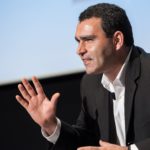 You could say that the three of us were walking to the park, but in truth Pinky was merely along for the ride. Sitting tall in his new chariot, our Frenchie sniffed in the sights as if his ‘hood had been transformed. Hands, those most desired instruments of affection, were suddenly at cheek level, drawn in by his come hither gaze. Few were immune to his entreaties especially his fellow geriatrics who enjoyed comparing heart meds though one contrarian vigorously recommended homeopathic hawthorne with a touch of cayenne. Inured to all but attention, King Pinky was bemused. Thus began our new normal.
You could say that the three of us were walking to the park, but in truth Pinky was merely along for the ride. Sitting tall in his new chariot, our Frenchie sniffed in the sights as if his ‘hood had been transformed. Hands, those most desired instruments of affection, were suddenly at cheek level, drawn in by his come hither gaze. Few were immune to his entreaties especially his fellow geriatrics who enjoyed comparing heart meds though one contrarian vigorously recommended homeopathic hawthorne with a touch of cayenne. Inured to all but attention, King Pinky was bemused. Thus began our new normal.
I offer this window into our Sunday sojourn as a reminder that a change in perspective, even one forced upon you, can open your eyes to new opportunities. Storytelling, as explained by Douwe Bergsma, Georgia Pacific’s CMO, is indeed a different way of looking at marketing communications, one that requires new processes, metrics and staff. In this last part of our interview you will find some of the fascinating details that often separate a good story from a great one concluding with three secrets to success should you want to embark on a storytelling adventure of your own.
Drew: Are your KPIs different than you would have had in a pre-storytelling era?
Douwe: On a high level, I don’t think so. We still look at brand awareness and key brand attributes and the impact it has on penetration, loyalty and ultimately our profit. We just noticed that the way we were approaching it, we were not optimally achieving our KPI. We still want to see how Brawny does with the idea of toughness and gentleness. We still want to know if our core consumers- our key target segments- still appreciate Brawny in a way that they are receiving the right value for their money, compared to their alternatives. At the highest level, it didn’t change. At the lower level, it did, because before we were single-mindedly measuring the impact of a 30-second ad on this metric. Now we look at the combined impact recognizing that at the end of the day, it’s still about driving conversion from intent to purchase.
Drew: Do marketers need to be more patient with storytelling?
Douwe: Good question, I haven’t thought about that. In the development, yes. It takes longer for a fully integrated story to develop because design plays a key role. One of the things we’ve learned is that a story needs to be holistic including the design of the brand packaging as well as the design of the products inside. One example of this is the way the Brawny giant comes to life on our packaging. And packaging, in our industry, has a longer lead-time. So in order to do it right and holistically, it takes longer to prepare and develop. In actuality, I don’t think the level of patience is different from what we used to do.
Drew: Let’s get specific. What’s your leading example of storytelling?
Douwe: Brawny is the only brand where we have completely overhauled our packaging as well as our other touch points. We’ve developed our story frame work– the conflict is really between tough and gentle. And then the fundamental human truth is about protecting yourself and those you love. This requires you to be understanding and open to what life throws at you, but also have the tenacity, toughness, and strength to tackle any challenge. We were inspired by a quote from Roosevelt: “speak softly and carry a big stick, you will go far.” We translated that into a campaign, featuring the Brawny giant. How do you tackle and handle life’s challenges? By staying strong while continuing to be gentle as these challenges come at you. We showcase The Brawny® Man with the larger-than-life look he had in the 1970s — so there’s kind of a double meaning here — in our campaign, which represents kind of a gentle giant, which is gentleness and strength in there.
Drew: Tell me more about your partnership with AOL.
Douwe: With AOL, we were able to develop and sponsor content that helped tell our various brand stories. For example, in Brawny®’s Everyday Giants series, we featured Khali Sweeney, who started the Downtown Boxing Gym in Detroit, which basically became an afterschool academic support program, where he gives kids free boxing lessons after they finished their homework. The program was for inner city kids in Detroit and every student who went through his program that’s been going on for several years now, there’s a 100 percent graduation rate and 80 percent went to college.
Drew: In a programmatic real-time world, how do you adjust to storytelling or does that play any kind of role in all of this?
Douwe: Programmatic is more into where and when and what frequency; it’s less about the content. And our storytelling predominantly focuses on the content of our communication, which closely relates to our media placement. So programmatic has not really impacted the story we’re telling, more when and where we telling it. And obviously, it allows us to find those people that are in our target audience. It allows us to find our specific audience better and faster than we normally do.
Drew: What are some of the pitfalls to be avoided?
Douwe: First and foremost, it’s very tempting to just focus on the storytelling. You first need to really focus on the story framework. Because our whole industry is so used to drafting a brief to develop an ad. Draft a brief; write a Tweet. But before you do the brief, you actually need to know your story’s framework. It’s like sending an improv artist on stage who doesn’t know what a story framework is.
Second, with storytelling there is not a single linear pass to it. You need to be very agile and experimental and embrace the mistakes and the failures you have along the way and have a very experimental mindset. You need to do a lot of trial and error and go down specific pathways to figure out what’s going to work for the brand or what doesn’t.
And last but not least, we’ve learned that you also need to make sure that you recruit and cherish the few storytellers in the building who have the passion and the talent to develop story frameworks. I discovered that there are quite a few people that have that innate balance at companies like Coca-Cola. In fact, Shari Neumann, who leads all our storytelling here at Georgia-Pacific is a former Coca-Cola person.

 It was one of those rare Los Angeles days — smog free, blue skies and the air was crisp. A perfect set up for what I hoped would be a perfect pitch. We were sitting in a diner right across the street from the bank headquarters in Pasadena and we were the opposite of stressed out. Like well-prepared boxers, we were ready, really ready. We were confident in our strategic sharpness and that we had the big idea. We even had most of the critical tactical details worked out to deliver a successful launch campaign. So when we walked over to the bank about 15 minutes before the appointed hour, witnesses might have seen a slight swagger in our step. Little did we know that our swagger was about to be shattered.
It was one of those rare Los Angeles days — smog free, blue skies and the air was crisp. A perfect set up for what I hoped would be a perfect pitch. We were sitting in a diner right across the street from the bank headquarters in Pasadena and we were the opposite of stressed out. Like well-prepared boxers, we were ready, really ready. We were confident in our strategic sharpness and that we had the big idea. We even had most of the critical tactical details worked out to deliver a successful launch campaign. So when we walked over to the bank about 15 minutes before the appointed hour, witnesses might have seen a slight swagger in our step. Little did we know that our swagger was about to be shattered.